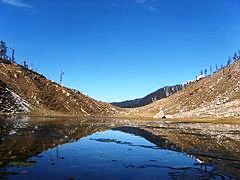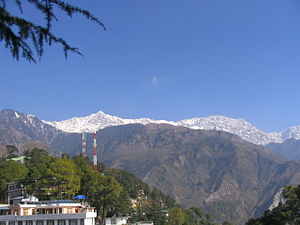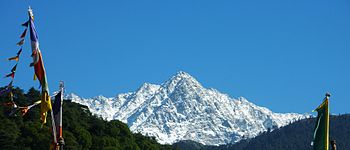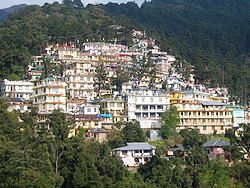Adventures journey in Himachal Pradesh
Himalaya is not only a mountain but also full of attractive places, some of them have been developed into tourist centers while most places where man has not yet set his eyes or could not reach there despite having all modern facilities and technologies. Most beautiful places have yet to become part of tourist maps and once the come to knowledge of man the places become crowded ultimately. The Himalaya is full of lakes, caves and other streams where there is no population hence the places are still neat and clean but how long, that is not yet sure. I came to know about such a place through one of my Kashmiri coworker who lives in Chandigarh for more than two decades on permanent basis and he is a fun loving guy who loves trekking.
He had accompanied me on many trekking tours mostly in Himachal, Jammu & Kashmir and Uttrakhand during our posting in Delhi regional office.
This was about ten years before on May23rd while he came to my house to attend my birthday party when he mentioned about a place in Kangra district of Himachal Pradesh. He heard about the place where a few lakes, caves were located, almost unnoticed from hawkeyed tourist operators. Actually, a local person told about these destinations on his official tour to Chamba where he had gone to attend project managers of different companies engaged in producing hydroelectric.
 Kareri Lake
Kareri Lake
The place I am describing is Kareri Lake which has now somewhat come to tourist map and recognized but when we decided to go there almost a decade back, it was not much heard of or visited and as much as I know the place has still no proper road connection until today. The hard-core adventure lovers still trek the place from Dharmshala, a famous town in Himachal Pradesh. We, me and Vijay Koul my friend started from Delhi the next morning for Dharmshala where we stayed overnight. Next morning we started for McLeod Ganj as we were told that a bus for Kareri would be available from there but when we reached to McLeod Ganj, we were disappointed to know that bus was available for Ghera village from Dharmashala itself. Since McLeod Ganj is a very famous hill station and Buddhist town also known as mini Lhasa where Dalai Lama and thousands of other Tibetans live since they have migrated to India after Chinese invasion in Tibet. This town is like a Tibetan town and very famous for its tourists value spots. Since we were in the famous tourist place where I had never come before therefore I wanted to see a few places like Bhagsunag temple only 2km away from town and Bhagsu waterfall a little further up.
McLeod Ganj
We wanted to go back to Dharmshala to catch a bus for Ghera village but as the bus services were not available after 4pm in the hills therefore as we were not sure if we could reach and get bus for Ghera we enquired about alternates for reaching to Ghera from McLeod Ganj itself. We soon came to know about a non-conventional rout to Ghera, there was a bus service up to Naddi a small village. We took a chance and took first bus to Naddi only a walking distance from town say about 3-4 km in Dhauladhar range of Himalayas where people where people visit for picnic purpose now as it has been developed recently. However, we continued our journey through narrow mountain trails passing through small hill villages Gatdi and Nora to move toward Ghera and reached to Ghera village finally by the sunset.
Night stay at Ghera
The journey from Naddi to Ghera is not very distant but too tedious due to steep rises, sudden drops to rise again, and that too on muddy narrow paths full of stones that took a big toll of us. As my friend, Vijay who can speak local language fluently since he has been staying in Chandigarh for years and a frequent traveler officially and as tourist took no time to arrange for our night stay and meals with village chief a very gentle person who took special care himself to make us comfortable. Probably the comfort we enjoyed at the house of village chief forced to sleep until late hours and we started our further journey after a breakfast and a promise to come back after our visit to Kareri Lake. He even provided us with two sleeping bags in case we decided to stay there overnight. Pan Singh the village chief had described the way to Lake in detail but once out of village it took us some time to find the right way to lake. But once we found the right path leading to Dal lake we had no further problem, incidentally every lake is Dal Lake in this area, as people know them with this name only. We ultimately reached to an under construction road and a little further to an old bridge, not motorable though but good enough to cross on foot. We did not have to cross that bridge but that was landmark to a narrow way just before that bridge goes to Lake. We walked on that straight steep and reached to a place where we could see few wooden structures covered with tarpaulins having few bottles of water and few homemade eatables including fruits sold by local villagers to rare tourists passing through this narrow footway. We bought two walking sticks, few packets of salted bafflers, water bottles and bananas. We found another source of water on our way to lake ‘Jamu Goth’ near an old rusty iron bridge, where shepherds brought their cattle mostly small sized cows, goats and sheep.
On our way

From Jamu Goth onward the way is along a small River Nyund in the lap of Dhauladhar range of hills scaling up to the height of 5,000mtr covered with snow most of the year. The fact is that if we stand somewhere in Punjab or surrounding Haryana we can see these hills of Dhauladhar from almost everywhere along with Shivalik range particularly in between Punjab and Kangra where most hills are in the range of 1,000mtr therefore Dhauladhar is clearly visible being at 5,000mtr height. As Dharmshala and McLeod Ganj fall under Dhauladhar range of hills, where lot of rain takes place almost every day so these places are also known as Cherrapunji of Himachal. It was already showing signs of rain with clouds every where when we were still at Jamu Goth and by the time we had covered another 2 km it had already started to rain so we took our raincoats out and covered ourselves and our backpacks. We were hungry, tired and now this rain made things a little more difficult as the pathway we were walking on was too slippery and stones allover the way. Things worsened a few minutes later when hailstones began to shower in big quantity all of a sudden and these were not ice pellets but full-fledged hailstones big and thick. We wanted to stop somewhere to take shelter but as we were not sure about duration, the rain could continue so we decided to keep moving. After all, we were passing through Cherrapunji of Himachal where it rains every day. Just after crossing the bridge, we saw a tent area by a trekking party, when the Lake was still 5km away but despite our temptation to stop here for some time we managed to march forward although it was still raining cats and dogs.
Steep climb and rain
Although we had decided to come back by the evening after visiting Kareri Lake but as soon as we saw tents set around Lake and arrangements of meals, we changed our program and began to think in terms of staying there overnight. However, from this point onward the walk became too difficult as the steep climb made it too tough to walk as rain, hailstones and big stones allover the steps were making way too slippery to walk. Whenever we saw a small cave it was like inviting us to take shelter but we had decided to not to stop as there was no guarantee of rain stopping the way it was raining. Another reason that we did not want to stop was the regular lightning and thundering clouds could block our way if striking resulted in smashing and falling trees and rocks. There was another plus point of walking that was helping our bodies keeping warm otherwise we could have frozen due to cold despite all the clothes and protection we had therefore we decided against staying and moved on.
Now we wanted to stop
 We kept walking in rain and hailstones when suddenly I heard Vijay saying- ‘no more walking, stop somewhere’ I was bit taken aback and asked him the reason. He said- we are walking towards clouds and, what if lightning stuck us? Lightning stuck us! That was some thing, I did not think of for a moment I was not sure about it but still decided to stop, as I did not want to force my decision on him. Now while we searched for a suitable shelter, we could not find any as only rocks and stones and nothing else was to be seen any where around. Suddenly we saw a hut across the river but the water was flowing to fast to cross and reach to the other bank as long as it was raining therefore we decided to sit beneath a big tree trunk found fallen nearby. That was not much of a shelter but saved us from direct hit from the stones. Later when rain slowed down about an hour later and flow of water receded, we somehow managed to cross the river climbing on big stones. The hut was empty as none was there, now we had a roof on our heads and we were safe from the rain that has begun again. There were dry wood available in the hut but the problem was we had no matchbox to start a fire. We even searched our backpacks but we found no matchbox and to our surprise, our clothes too were wet. We tried every trick of the trade to light a fire but in vain. Later a shepherd appeared, who had seen us crossing the river and lighted fire for us that was as god sent help for us.
We kept walking in rain and hailstones when suddenly I heard Vijay saying- ‘no more walking, stop somewhere’ I was bit taken aback and asked him the reason. He said- we are walking towards clouds and, what if lightning stuck us? Lightning stuck us! That was some thing, I did not think of for a moment I was not sure about it but still decided to stop, as I did not want to force my decision on him. Now while we searched for a suitable shelter, we could not find any as only rocks and stones and nothing else was to be seen any where around. Suddenly we saw a hut across the river but the water was flowing to fast to cross and reach to the other bank as long as it was raining therefore we decided to sit beneath a big tree trunk found fallen nearby. That was not much of a shelter but saved us from direct hit from the stones. Later when rain slowed down about an hour later and flow of water receded, we somehow managed to cross the river climbing on big stones. The hut was empty as none was there, now we had a roof on our heads and we were safe from the rain that has begun again. There were dry wood available in the hut but the problem was we had no matchbox to start a fire. We even searched our backpacks but we found no matchbox and to our surprise, our clothes too were wet. We tried every trick of the trade to light a fire but in vain. Later a shepherd appeared, who had seen us crossing the river and lighted fire for us that was as god sent help for us.
Toward the Lake again
We started again as the rain stopped about an hour later and by then we were feeling safe, warm and comfortable. We saw few more tents as we approached the Lake Kareri at about 7 pm a journey of 13km that took us almost nine hours. We found a temple and few rooms for tourists to stay. We went inside the rooms but these tin roofed rooms were in bad condition. The roofs were not good enough to protect us being torn at several places, which were not able to stop rainwater to enter inside the room and making place waterlogged allover. The walls were broken having big holes allowing chilled wind to cross and fill the place. I came out of the room and looked around to find a few huts little further up, as I did not see any smoke coming out of those huts I knew that those too were not populated but used while needed by the shepherds who need these huts during grazing their cattle. We two walked to those huts and entered one of them that was filled with mud and in no position to house any one, the second one was still worse with a dead goat lying there and stinking.
There was no hut, which could offer us any shelter, therefore we went back to rooms near the temple and took the best available room that had three walls and a broken roof. The rain had started pouring once again with all its might and the hailstones were bigger this time around. The storm was at its peak and whenever the wind entered in the room with force, it felt like it would take us with it. The tinned roof was making so much of noise as the wind was shaking it that made us feel as if the stones were hitting it coming down from hilltops. That was a terrifying night, which we passed eating whatever we had with us, as nothing else was available there. We took our sleeping bags out to hide ourselves into them. Anyway, we did manage to sleep and to our surprise, it was a sunny day in the morning with no sign of past night. First thing we did in the morning was to spread our wet clothes in the sun outside before going through the daily routine and answering to nature’s call.
Kareri Lake
The lake is not a big one say about 2 km all around but the beauty and the location is stunning. The lake was in nowhere in tourists’ guides when we visited it, although some of the tour operators have started it bringing to their program. They are marketing the place too furiously to make it a holiday program for seven days while two days are more than sufficient if everything goes right. There is another pass named Minkiani at about 4250mt from sea level only 4km away from here that can be added in the program. We could have gone back from Kareri to Kangra or Pathankot via Nani and Shahpur but as we had sleeping bags to return to village chief in Kareri, we went back through the same rout to come back to Delhi.
Finally
Let me put it in a nutshell that Kareri Lake is only a small Lake near McLeod Ganj at the height of 11,000ft from sea level, that is about 2km if you walk around it where mostly shepherds known as Gaddis found grazing their cattle. The Minkiani Pass is about 4km from here at the height of 14,000ft, from sea level and one can cross over to Chamba from here. If any one wants to visit this area should do it in summers only as other months find the area totally covered with snow and even the lake remains nothing but frozen. There is another Lake Lam Dal in the area where tourists can go for a brief visit. We did not visit some places worth visiting but if you have time to spare, here are some places where you can visit in this particular area-
- Nag dal to Lam dal height 3800mt. distance about 7km
- Macleod Ganj to Triund - height 2975m distance 9 Km
- The trek through forests of oak, pines and deodar is a steep rising walk of about 2km later goes down slowly to reach to temple of Galu Devi.
- Triund to Lahesh cave height 3500m distance only 6km with night stay in tents at caves
- Kareri village to Guna temple height 2400mt at a distance of about 10 km.
- Guna temple to MacLeod Ganj is a wonderful trekking experience while coming back although most visitors find it too tough a job after a tiring trip of high altitude trekking trip.
Photo source wikipedia
